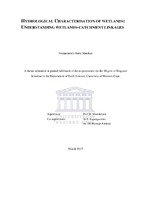| dc.description.abstract | This study explores the hydrological processes of selected wetlands in four different catchments in South Africa (the Nuwejaars River in the Western Cape which has the Elandsdrift-Wiesdrift wetland; the Mohlapetsi river in the lower Olifants river in Limpopo where the GaMampa wetland is located; the Usuthu River in Mpumalanga which has the Bonnie Brook wetlands; and the UMgeni River in KwaZulu Natal with the Lions river wetlands). The representation of wetlands processes in the Pitman and Agricultural Catchments Research Unit (ACRU) - commonly used hydrological models in Southern Africa - is also evaluated. In the Nuwejaars river catchment, hydrological processes were monitored for over a year, while literature and available conceptual frameworks were used in the other catchments. The Pitman and ACRU models were used to represent the main process and to determine how wetlands influence catchment-scale processes. Current understanding of the hydrology of Elandsdrift-Wiesdrift floodplain suggests that the floodplain is dominated by precipitation, overland flow from the catchment area of the floodplain, evapotranspiration, and surface flow from the left sides of the floodplain to the Nuwejaars River. In the Mohlapetsi River catchment the GaMampa wetland is dominated by local rainfall falling directly onto the wetland, surface runoff from the valley sides, and spring flow at the bottom of the surrounding hills occasioned by recharge on the hills, evapotranspiration and lateral flow between the wetland to the river. The Bonnie Brook and Lion's river catchment are valley bottom floodplains dominated by evapotranspiration, precipitation, overland flow, overbank flooding, groundwater discharge and groundwater recharge. Hydrological modelling of wetlands in the four basins yielded reasonable success (Nash Sutcliffe (NSE) ranged from 0.510 to 0.75 with less than 15% percentage of different between observed and selected mean values (PBIAS). Most characteristics of the observed flows for the four catchments were satisfactorily simulated. The overall results from both models indicate that the models can reasonably represent hydrological processes of wetlands, though there is need to improve the routines in both models. Therefore, further studies that will focus on parameter estimation and improving the current wetland modules of both models are recommended. | |

